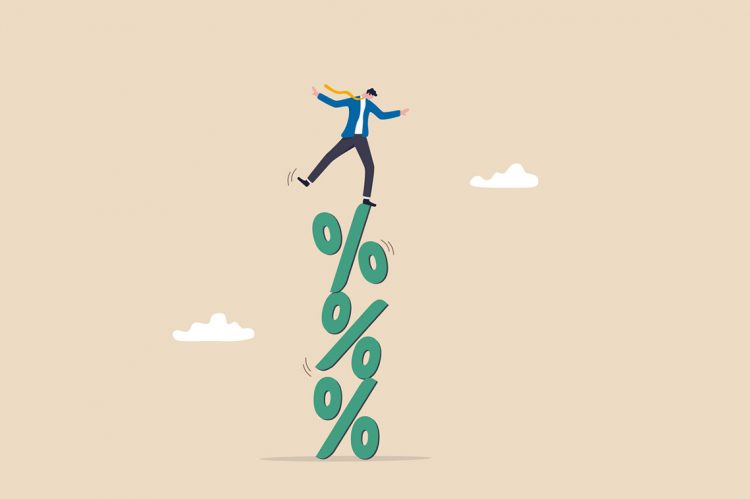The average 30-year-fixed mortgage rate rose to its highest level in two decades this week, as inflation persists. Rates jumped 7.08%, up from last week’s 6.94% mark, according to the latest Primary Mortgage Market Survey® (PMMS®) from Freddie Mac.
Here’s how rates are looking this week:
- 30-year fixed-rate mortgage averaged 7.08% with an average 0.8 point as of October 27, 2022, up from last week when it averaged 6.94%. A year ago at this time, the 30-year FRM averaged 3.14%.
- 15-year fixed-rate mortgage averaged 6.36% with an average 1.4 point, up from last week when it averaged 6.23%. A year ago at this time, the 15-year FRM averaged 2.37%.
- 5-year Treasury-indexed hybrid adjustable-rate mortgage (ARM) averaged 5.96% with an average 0.3 point, up from last week when it averaged 5.71%. A year ago at this time, the 5-year ARM averaged 2.56%.
What the experts think:
“The 30-year fixed-rate mortgage broke seven perent for the first time since April 2002, leading to greater stagnation in the housing market,” said Sam Khater, Freddie Mac’s chief economist. “As inflation endures, consumers are seeing higher costs at every turn, causing further declines in consumer confidence this month. In fact, many potential homebuyers are choosing to wait and see where the housing market will end up, pushing demand and home prices further downward.”
Nadia Evangelou, NAR senior economist and director of forecasting, commented:
“Generally, during inflationary periods, people hold less money and, thus, spend less. However, that’s not currently the case. Amid elevated inflation and higher interest rates, the U.S. economy grew more than expected, easing inflation fears for the time being. As a result, mortgage rates surpassed the 7% threshold this week. According to Freddie Mac, the 30-year fixed mortgage rate rose to 7.08% from 6.94% the previous week. Rising mortgage rates have increased the monthly mortgage payment by $1,000, and minority groups may be impacted more heavily. Although mortgage rates reached all-time lows in 2021, not everybody was able to benefit from these low rates. During 2019 and 2021, the White homeownership rate rose by nearly 3 percentage points, while the homeownership rate for Black Americans rose by 2 percentage points. With 7% mortgage rates, only 15% of Black households can currently afford to buy the typical home compared to 30% of White households. Thus, Black families may fall further behind in homeownership compared to their White counterparts.”
Realtor.com® Economic Data Analyst Hannah Jones commented:
“The Freddie Mac rate for a 30-year home loan rose 14 basis points this week, reaching 7.08% as the 10-year treasury yield remained above 4%. This marks the first week mortgage rates have crossed the 7% threshold since April 2002. Markets are preparing for next week’s Fed meeting and the resulting interest rate hike. In line with the last three meetings, next week’s session is expected to bring a 75-basis point hike as the most recent inflation data does not show sufficient signs of cooling. Four 75 basis point hikes in a row marks the largest series of target federal funds rate hikes in more than three decades. The FOMC is set to discuss future hikes at next week’s meeting as the committee aims to bring down stubborn inflation without leading to widespread unemployment or economic strife.
“Mortgage rates have climbed 394 basis points in the last 12 months and listing prices have increased 13.9%, meaning the monthly payment on a median priced home is 78% higher today compared to one year ago for buyers who put 20% down. This translates to a whopping $1,000 increase in the typical home payment in just the last year. Home shoppers are hamstrung by the rising cost of homeownership and inflation which has led many to drop out of the market as shown by September’s 23.8% drop in existing home sales year-over-year, the eighth month of decline in a row.
Hopeful buyers who remain on the hunt are finding affordability by searching in lower priced markets. As a result, affordable markets are seeing sustained housing demand. Many of the year’s third quarter emerging housing markets are affordable places that offer a strong local economy. These affordable markets, similar to September’s hottest markets, have continued to see substantial demand despite the shifting housing market. As long as mortgage rates and prices remain high, buyers will be looking for a relief valve. Some may find renting to be the better option in the short term, while others may consider other home types such as condos. Buyers who remain in the market may see lower prices and have some leverage relative to the last few months, though they will have to be cognizant of how higher mortgage rates impact housing costs,” Jones concluded.












